Spectral and Timing Properties of H 1743-322 in the “Faint” 2005 Normal Outburst
Abstract
1. Introduction
2. Data Reduction and Analysis
3. Results
3.1. Timing Analysis
3.2. Spectral Analysis
3.3. Relation of Timing and Spectral Properties
4. Discussion
5. Summary
Author Contributions
Funding
Institutional Review Board Statement
Informed Consent Statement
Data Availability Statement
Acknowledgments
Conflicts of Interest
References
- Athulya, M.P.; Radhika, D.; Agrawal, V.K.; Ravishankar, B.T.; Naik, S.; Mandal, S.; Nandi, A. Unravelling the foretime of GRS 1915+105 using AstroSat observations: Wide-band spectral and temporal characteristics. Mon. Not. R. Astron. Soc. 2021, 510, 3019–3038. [Google Scholar] [CrossRef]
- Liu, X.; Chang, N.; Wang, X.; Yuan, Q. The Origin of Radio Emission in Black Hole X-ray Binaries. Galaxies 2021, 9, 78. [Google Scholar] [CrossRef]
- Sriram, K.; Harikrishna, S.; Choi, C.S. Spectro-temporal Studies of Rapid Transition of the Quasi-periodic Oscillations in the Black Hole Source H 1743-322. Astrophys. J. 2021, 911, 17–56. [Google Scholar] [CrossRef]
- Casella, P.; Belloni, T.; Stella, L. The ABC of Low-Frequency Quasi-periodic Oscillations in Black Hole Candidates: Analogies with Z Sources. Astrophys. J. 2005, 629, 403–407. [Google Scholar] [CrossRef]
- Motta, S.E. Quasi periodic oscillations in black hole binaries. Astron. Nachrichten 2016, 337, 398–404. [Google Scholar] [CrossRef]
- Lazar, H.; Tomsick, J.A.; Pike, S.N.; Bachetti, M.; Buisson, D.J.; Connors, R.M.; Fabian, A.C.; Fuerst, F.; García, J.A.; Hare, J.; et al. Spectral and Timing Analysis of NuSTAR and Swift/XRT Observations of the X-Ray Transient MAXI J0637-430. Astrophys. J. 2021, 921, 14–30. [Google Scholar] [CrossRef]
- Yan, Z.; Rapisarda, E.; Yu, W.F. Detection of a Low-frequency Quasi-periodic Oscillation in the Soft State of Cygnus X-1 with Insight-HXMT. Mon. Not. R. Astron. Soc. 2021, 919, 9–20. [Google Scholar] [CrossRef]
- Nathan, E.; Ingram, A.; Homan, J.; Huppenkothen, D.; Uttley, P.; van der Klis, M.; Motta, S.; Altamirano, D.; Middleton, M. Phase-resolved spectroscopy of a quasi-periodic oscillation in the black hole X-ray binary GRS 1915+105 with NICER and NuSTAR. Mon. Not. R. Astron. Soc. 2022, 511, 255–279. [Google Scholar] [CrossRef]
- Motta, S.E.; Casella, P.; Henze, M.; Muñoz-Darias, T.; Sanna, A.; Fender, R.; Belloni, T. Geometrical constraints on the origin of timing signals from black holes. Mon. Not. R. Astron. Soc. 2015, 447, 2059–2072. [Google Scholar] [CrossRef]
- Belloni, T.; Zhang, L.; Kylafis, N.D.; Reig, P.; Altamirano, D. Time lags of the type-B quasi-periodic oscillation in MAXI J1348-630. Mon. Not. R. Astron. Soc. 2020, 496, 4366–4371. [Google Scholar] [CrossRef]
- Yan, Z.; Yu, W.F. Detection of X-ray spectral state transitions in mini-outbursts of black hole transient GRS 1739-278. Mon. Not. R. Astron. Soc. 2017, 470, 4298–4306. [Google Scholar] [CrossRef]
- Xie, F.G.; Yan, Z.; Wu, Z.Z. Radio/X-Ray Correlation in the Mini-outbursts of Black Hole X-Ray Transient GRS 1739-278. Astrophys. J. 2020, 891, 31–39. [Google Scholar] [CrossRef]
- Zhang, G.B.; Bernardini, F.; Russell, D.M.; Gelfand, J.D.; Lasota, J.P.; Qasim, A.A.; AlMannaei, A.; Koljonen, K.I.I.; Shaw, A.W.; Lewis, F.; et al. Bright Mini-outburst Ends the 12 yr Long Activity of the Black Hole Candidate Swift J1753.5-0127. Astrophys. J. 2019, 876, 5–16. [Google Scholar] [CrossRef]
- Hynes, R.I.; Mauche, C.W.; Haswell, C.A.; Shrader, C.R.; Cui, W.; Chaty, S. The X-Ray Transient XTE J1118+480: Multiwavelength Observations of a Low-State Minioutburst. Astrophys. J. 2000, 539, L37–L40. [Google Scholar] [CrossRef]
- Dubus, G.; Hameury, J.M.; Lasota, J.P. The disc instability model for X-ray transients: Evidence for truncation and irradiation. Astron. Astrophys. 2001, 373, 251–272. [Google Scholar] [CrossRef]
- Hameury, J.M.; Lasota, J.P.; Warner, B. The zoo of dwarf novae: Illumination, evaporation and disc radius variation. Astron. Astrophys. 2000, 353, 244–253. [Google Scholar]
- Cooke, B.A.; YLevine, A.M.; Lang, F.L.; Primini, F.A.; Lewin, W.H.G. HEAO 1 high-energy X-ray observations of three bright transient X-ray sources H 1705-250 (nova Ophiuchi), H 1743-322 and H 1833-077 (Scutum X-1). Astrophys. J. 1984, 285, 258–263. [Google Scholar] [CrossRef]
- Reynolds, S.P.; Chanan, G.A. On the X-ray emission from Crab-like supernova remnants. Astrophys. J. 1984, 281, 673–681. [Google Scholar] [CrossRef]
- Steiner, J.F.; McClintock, J.E.; Reid, M.J. The Distance, Inclination, and Spin of the Black Hole Microquasar H 1743-322. Astrophys. J. 2012, 745, L7–L11. [Google Scholar] [CrossRef]
- Bhattacharjee, A.; Banerjee, I.; Banerjee, A.; Debnath, D.; Chakrabarti, S.K. The 2004 outburst of BHC H 1743-322: Analysis of spectral and timing properties using the TCAF solution. Mon. Not. R. Astron. Soc. 2017, 466, 1372–1381. [Google Scholar] [CrossRef]
- Zhou, J.N.; Liu, Q.Z.; Chen, Y.P.; Li, J.; Qu, J.L.; Zhang, S.; Gao, H.Q.; Zhang, Z. The last three outbursts of H 1743-322 observed by RXTE in its latest service phase. Mon. Not. R. Astron. Soc. 2013, 431, 2285–2293. [Google Scholar] [CrossRef][Green Version]
- Belloni, T.; Motta, S.E.; Muñoz, D.T. Black hole transients. Bull. Astron. Soc. India 2011, 39, 409–428. [Google Scholar]
- Markwardt, C.B.; Swamk, J.H. XTE J1746-322 = Igr J17464-3213 = H 1743-322. Astron. Telegr. 2003, 133, 1–24. [Google Scholar]
- Mao, D.M.; Yu, W.F. Power spectral properties of the soft spectral states in four black hole transients. Res. Astron. Astrophys. 2021, 21, 12–25. [Google Scholar] [CrossRef]
- Cao, X.F.; Wu, Q.W.; Dong, A.J. Different X-ray spectral evolution for black hole X-ray binaries in dual tracks of radio-X-ray correlation. Astrophys. J. 2014, 788, 52–60. [Google Scholar] [CrossRef]
- Dong, A.J.; Liu, C.; Ge, K.; Liu, X.; Zhi, Q.J.; You, Z.Y. A Study on the Hysteresis Effect and Spectral Evolution in the Mini-Outbursts of Black Hole X-Ray Binary XTE J1550-564. Front. Astron. Space Sci. 2021, 8, 37–43. [Google Scholar] [CrossRef]
- Motta, S.E.; Darias, T.M.; Belloni, T. On the outburst evolution of H 1743-322: A 2008/2009 comparison. Mon. Not. R. Astron. Soc. 2010, 408, 1796–1807. [Google Scholar] [CrossRef]
- Magdziarz, P.; Zdziarski, A.A. Angle-dependent Compton reflection of X-rays and gamma-rays. Mon. Not. R. Astron. Soc. 1995, 273, 837–848. [Google Scholar] [CrossRef]
- Miyamoto, S.; Kitamoto, S.; Iga, S.; Negoro, H.; Terada, K. Canonical Time Variations of X-Rays from Black Hole Candidates in the Low-Intensity State. Astrophys. J. 1992, 391, L21–L24. [Google Scholar] [CrossRef]
- Vaughan, S.; Fabian, A.C. The high frequency power spectrum of Markarian 766. Astrophys. J. 2003, 341, 496–500. [Google Scholar] [CrossRef][Green Version]
- Berger, M. High time resolution observations of Cygnus X-3 with EXOSAT. Astron. Astrophys. 1994, 292, 175–182. [Google Scholar]
- Rodriguez, J.; Varnière, P. The Puzzling Harmonic Behavior of the Cathedral QPO in XTE J1859+226. Astrophys. J. 2011, 735, 79–85. [Google Scholar] [CrossRef]
- Miller-Jones, J.C.; Sivakoff, G.R.; Altamirano, D.; Coriat, M.; Corbel, S.; Dhawan, V.; Krimm, H.A.; Remillard, R.A.; Rupen, M.P.; Russell, D.M.; et al. Disc-jet coupling in the 2009 outburst of the black hole candidate H 1743-322. Mon. Not. R. Astron. Soc. 2012, 412, 468–485. [Google Scholar]
- Shui, Q.C.; Yin, H.X.; Zhang, S.; Qu, J.L.; Chen, Y.P.; Kong, L.D.; Wang, P.J.; Zhang, H.F.; Song, J.X.; Ning, B.; et al. State transitions of GX 339-4 during its outburst rising phase. Mon. Not. R. Astron. Soc. 2021, 508, 287–299. [Google Scholar] [CrossRef]
- Marcel, G.; Ferreira, J.; Petrucci, P.O.; Belmont, R.; Malzac, J.; Clavel, M.; Henri, G.; Coriat, M.; Corbel, S.; Rodriguez, J.; et al. A unified accretion-ejection paradigm for black hole X-ray binaries. VI. Radiative efficiency and radio-X-ray correlation during four outbursts from GX339-4. Astron. Astrophys. 2021, 494, L21–L24. [Google Scholar]
- Belloni, T.; Parolin, I.; Del Santo, M.; Homan, J.; Casella, P.; Fender, R.P.; Lewin, W.H.G.; Méndez, M.; Miller, J.M.; Van Der Klis, M. INTEGRAL/RXTE high-energy observation of a state transition of GX339-4. Mon. Not. R. Astron. Soc. 2006, 367, 1113–1120. [Google Scholar] [CrossRef]
- McClintock, J.E.; Remillard, R.A. Black Hole X-ray Binaries. Astron. Astrophys. 2004, 3, 1–58. [Google Scholar]
- Zhang, S.N. Black hole binaries and microquasars. Front. Phys. 2013, 8, 630–660. [Google Scholar] [CrossRef]
- Mosallanezhad, A.; Abbassi, S.; Beiranv, N. Structure of Advection-Dominated Accretion Disks with Outflows: Role of Toroidal Magnetic Field. Mon. Not. R. Astron. Soc. 2014, 437, 3112–3123. [Google Scholar] [CrossRef][Green Version]
- Reynolds, C.S. Observational Constraints on Black Hole Spin. Astron. Astrophys. 2020, 59, 35–76. [Google Scholar] [CrossRef]
- Gao, Z.F.; Shan, H.; Wang, H. The dissipation of toroidal magnetic fields and spin down evolution of young and strongly magnetized pulsars. Astron. Nachrichten 2021, 342, 369–376. [Google Scholar] [CrossRef]
- Gao, Z.F.; Peng, F.K.; Wang, N. The evolution of magnetic field and spin-down of young pulsars. Astron. Nachrichten 2019, 340, 1023–1029. [Google Scholar] [CrossRef]
- Liu, H.; Dong, A.J.; Weng, S.S.; Wu, Q.W. Evolution of the hard X-ray photon index in black-hole X-ray binaries: Hints for accretion physics. Mon. Not. R. Astron. Soc. 2019, 487, 5335–5345. [Google Scholar] [CrossRef]
- Dong, A.J.; Wu, Q.W.; Cao, X.F. A new fundamental plane for radiatively efficient black-hole sources. Astrophys. J. 2014, 787, 20–25. [Google Scholar] [CrossRef]
- Cao, X.W. An accretion disc-corona model for X-ray spectra of active galactic nuclei. Mon. Not. R. Astron. Soc. 2009, 394, 207–213. [Google Scholar] [CrossRef]
- Schnittman, J.D.; Krolik, J.H. X-ray Polarization from Accreting Black Holes: Coronal Emission. Astrophys. J. 2010, 712, 908–924. [Google Scholar] [CrossRef]
- Liu, X.; Han, Z.H.; Zhang, Z. The physical fundamental plane of black hole activity. Astrophys. Space Sci. 2016, 361, 9–14. [Google Scholar] [CrossRef][Green Version]
- Chang, N.; Xie, F.G.; Liu, X.; Ho, L.C.; Dong, A.J.; Han, Z.H.; Wang, X. Possible evidence of a universal radio/X-ray correlation in a near-complete sample of hard X-ray selected seyfert galaxies. Mon. Not. R. Astron. Soc. 2021, 503, 1987–1998. [Google Scholar] [CrossRef]
- Xu, Y.; Harrison, F.A.; Tomsick, J.A.; Hare, J.; Fabian, A.C.; Walton, D.J. Evidence for Disk Truncation at Low Accretion States of the Black Hole Binary MAXI J1820+070 Observed by NuSTAR and XMM-Newton. Astrophys. J. 2020, 893, 8–15. [Google Scholar] [CrossRef]
- Li, L.X.; Zimmerman, E.R.; Narayan, R.; McClintock, J.E. Multitemerature Blackbody Spectrum of a Thin Accretion Disk Around a Kerr Black Hole: Model Computations and Comparison with Observations. Astrophys. J. 2005, 157, 335–370. [Google Scholar] [CrossRef]
- Prieto, A.; Rodríguez-Ardila, A.; Panda, S.; Marinello, M. Erratum: A novel black hole mass scaling relation based on coronal gas, and its dependence with the accretion disc. Mon. Not. R. Astron. Soc. 2022, 511, 4444–4446. [Google Scholar] [CrossRef]
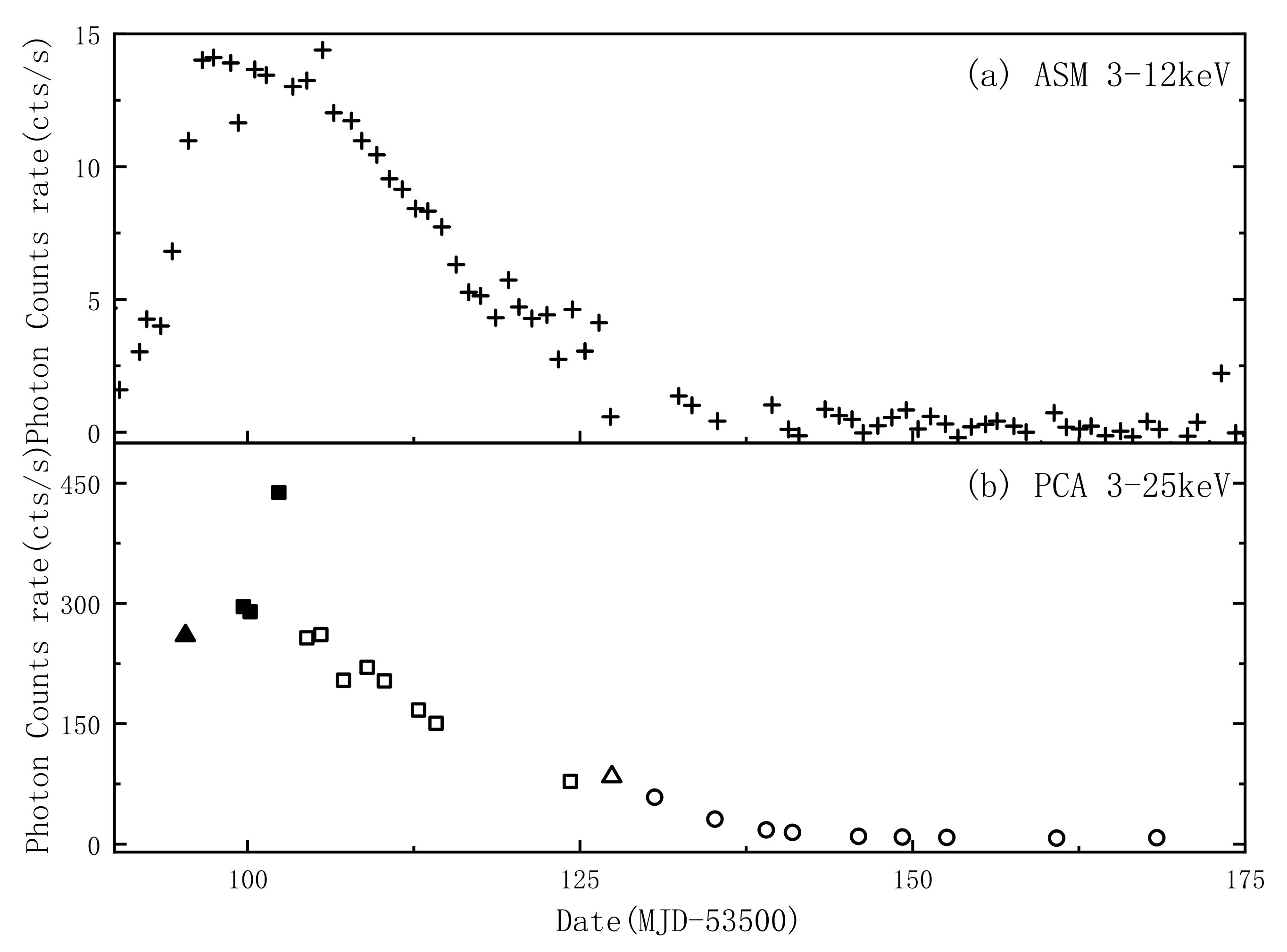
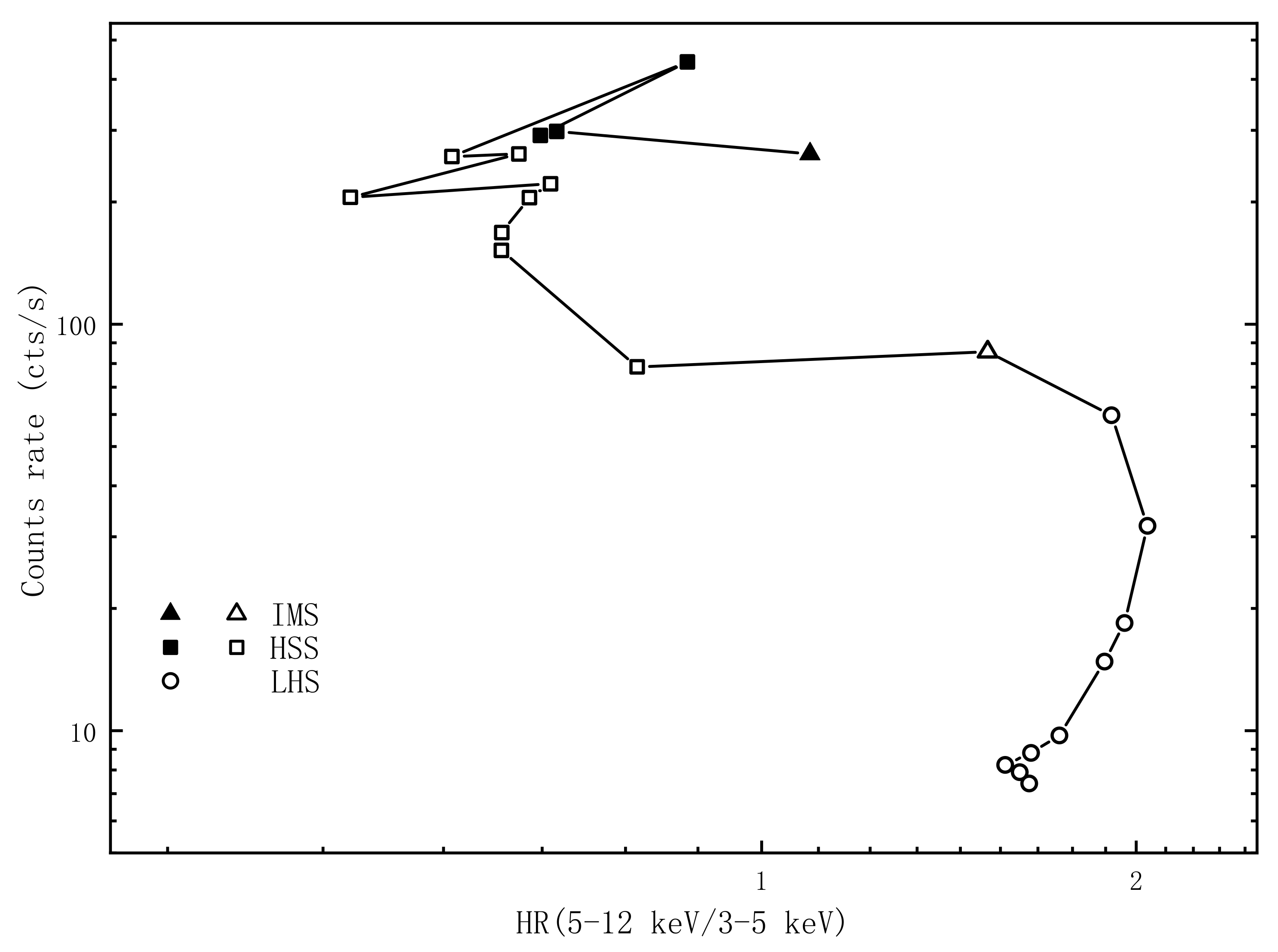
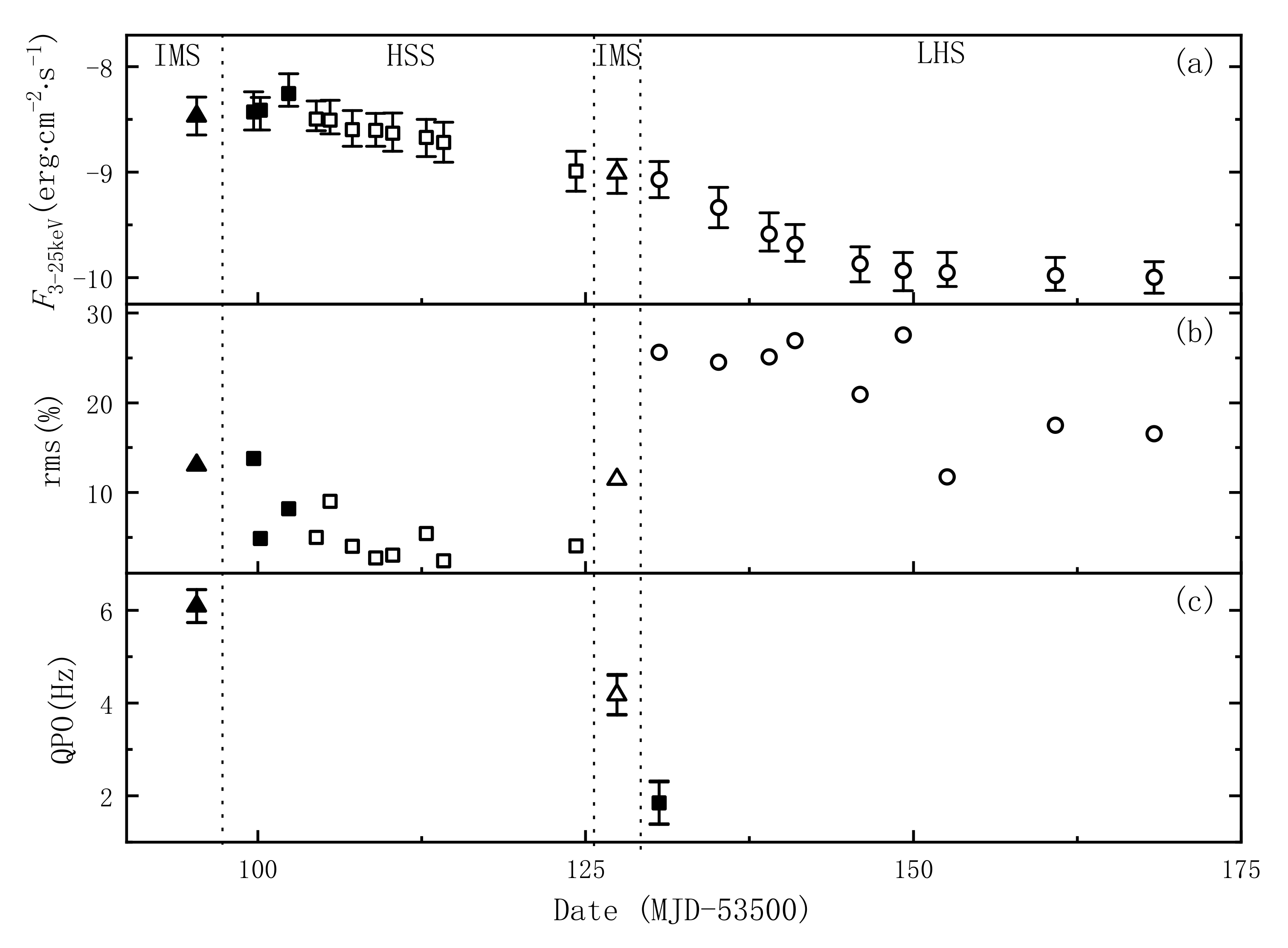

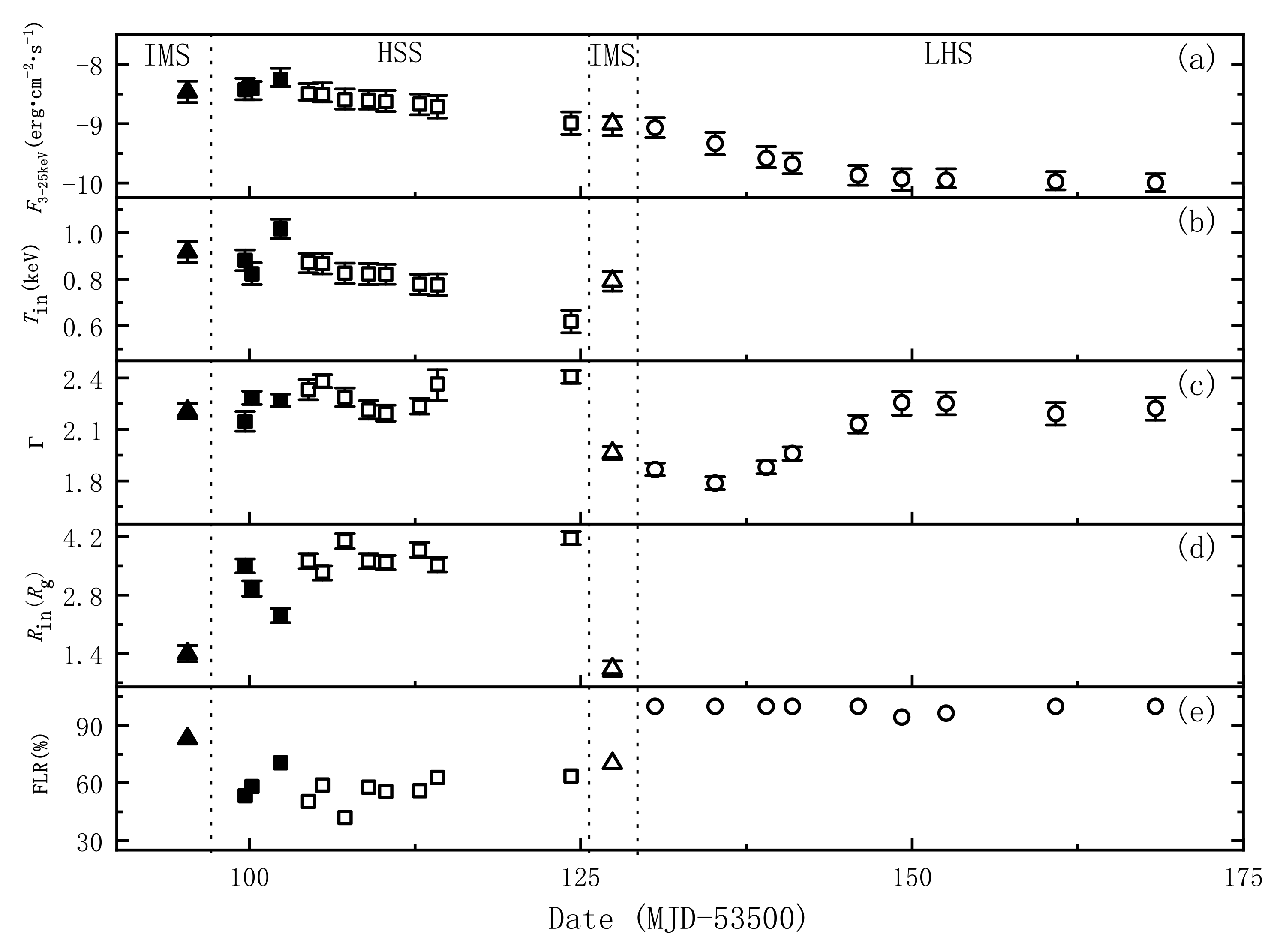
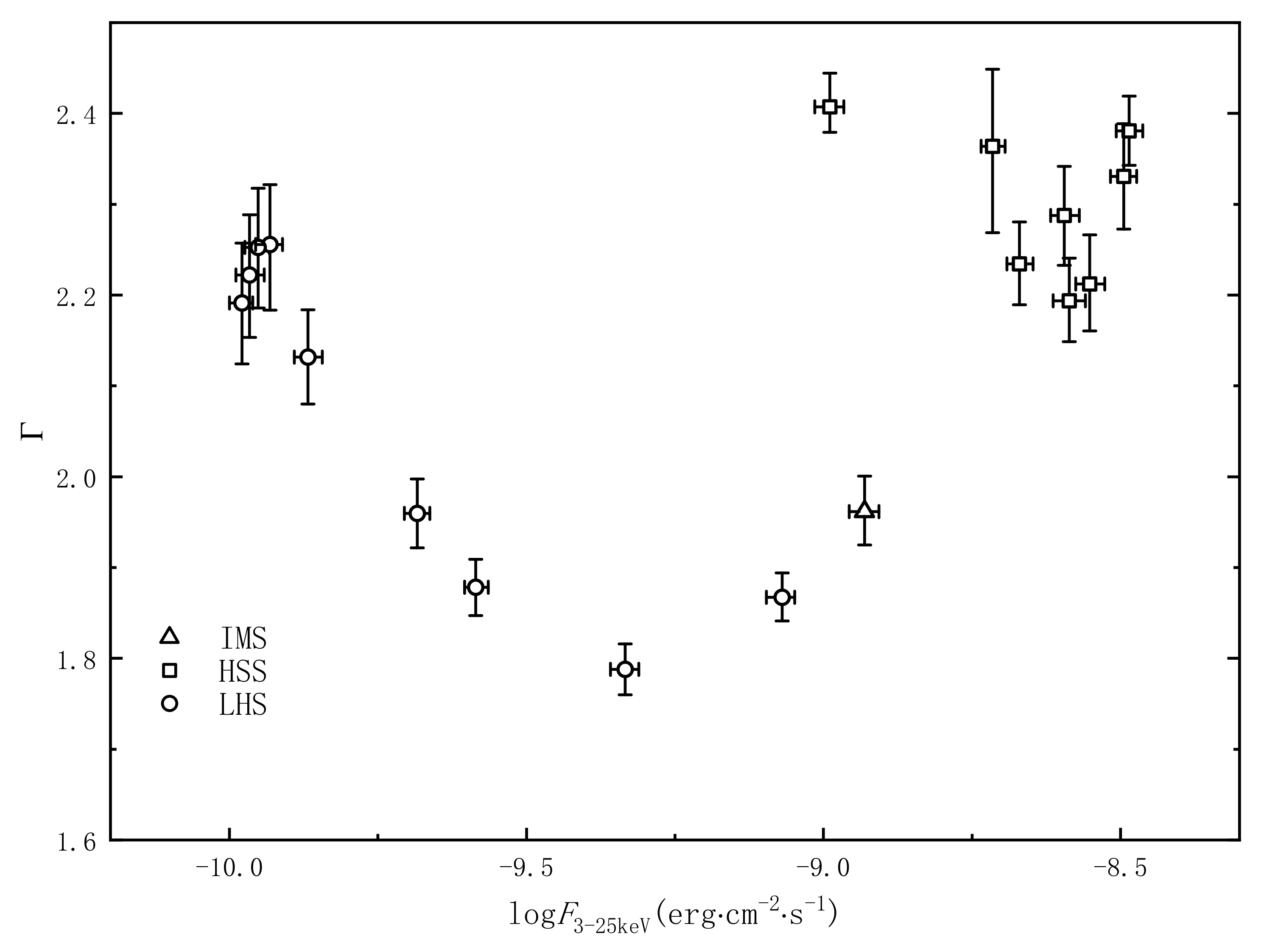
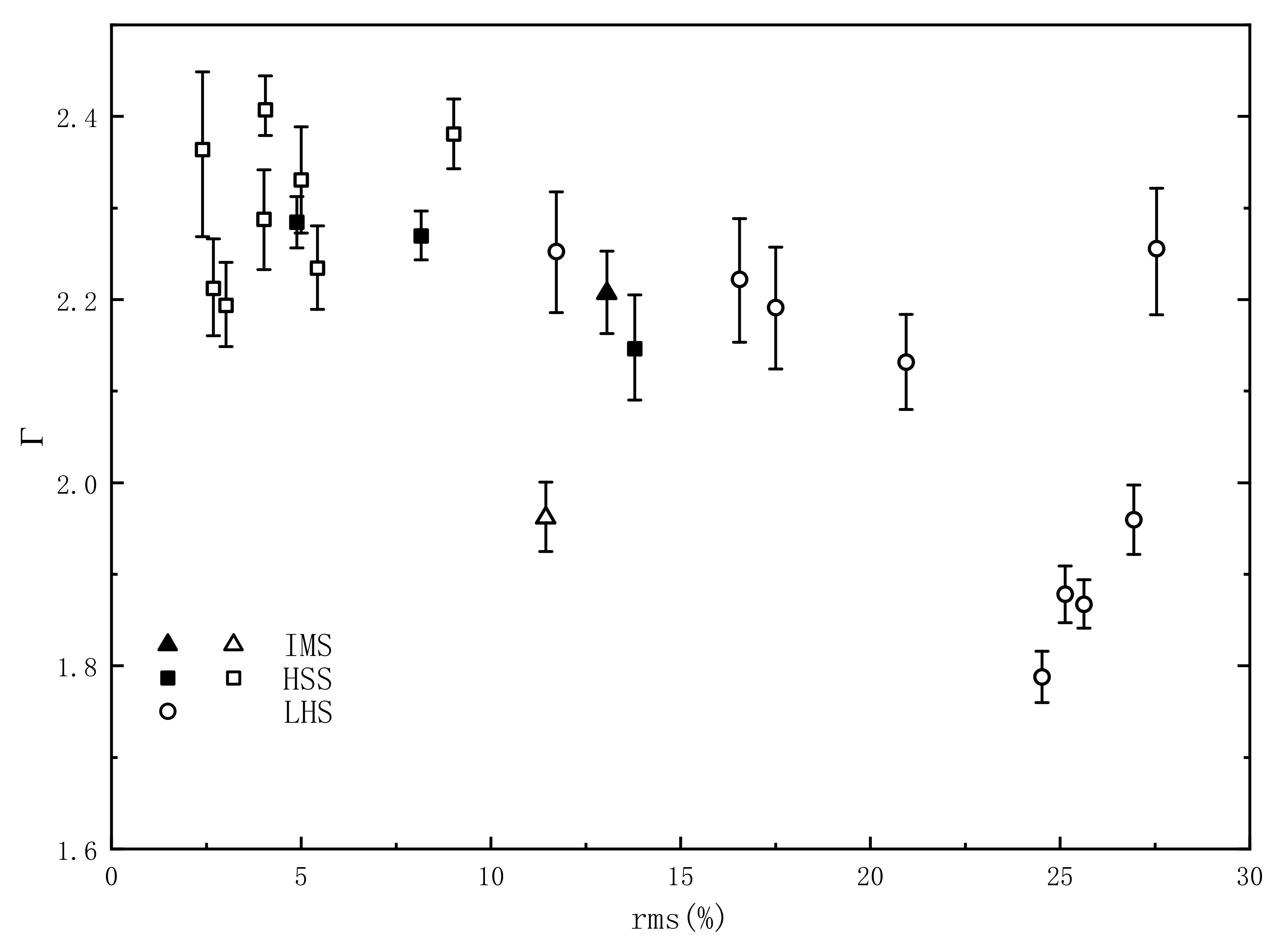
| Obs.Id | Log | FLR | d.o.f | Model | ||||
|---|---|---|---|---|---|---|---|---|
| (day) | (keV) | () | () | (%) | ||||
| 91050-06-01-00 | −1.73 | 78.58 | 0.55/82 | diskbb+gau+pow | ||||
| 91050-06-02-00 | −1.69 | 44.79 | 0.70/82 | diskbb+gau+pow | ||||
| 91050-06-03-00 | −1.67 | 49.26 | 1.26/84 | diskbb+pow | ||||
| 91050-06-04-00 | −1.51 | 65.38 | 1.07/84 | diskbb+pow | ||||
| 91050-06-05-00 | −1.75 | 40.01 | 0.75/84 | diskbb+pow | ||||
| 91050-06-06-00 | −1.76 | 48.91 | 1.29/84 | diskbb+pow | ||||
| 91050-06-07-00 | −1.85 | 31.02 | 1.30/84 | diskbb+pow | ||||
| 91050-06-08-00 | −1.86 | 46.77 | 0.83/82 | diskbb+gau+pow | ||||
| 91050-06-09-00 | −1.88 | 44.44 | 0.76/82 | diskbb+gau+pow | ||||
| 91050-06-10-00 | −1.93 | 42.71 | 0.76/82 | diskbb+gau+pow | ||||
| 91050-06-11-00 | −1.97 | 48.43 | 1.33/84 | diskbb+pow | ||||
| 91428-01-02-00 | −2.25 | 60.08 | 1.48/84 | diskbb+pow | ||||
| 91428-01-02-01 | −2.26 | 89.20 | 0.72/82 | diskbb+gau+pow | ||||
| 91428-01-03-00 | −2.33 | 100.0 | 1.11/86 | pow | ||||
| 91428-01-03-01 | −2.59 | 100.0 | 1.00/86 | pow | ||||
| 91428-01-04-00 | −2.84 | 100.0 | 1.22/86 | pow | ||||
| 91428-01-04-01 | −2.94 | 100.0 | 1.25/86 | pow | ||||
| 91428-01-05-00 | −3.13 | 100.0 | 1.28/86 | pow | ||||
| 91428-01-05-01 | −3.19 | 96.84 | 0.80/84 | gau+pow | ||||
| 91428-01-06-00 | −3.21 | 97.51 | 1.02/84 | gau+pow | ||||
| 91428-01-07-00 | −3.24 | 100.0 | 1.29/86 | pow | ||||
| 91428-01-08-00 | −3.26 | 100.0 | 1.14/86 | pow |
| Obs.Id | QPOs | |||
|---|---|---|---|---|
| (%) | (Hz) | |||
| 91050-06-01-00 | 13.06 | 0.982 | lo | |
| 91050-06-02-00 | 13.79 | 0.964 | lo+pow | |
| 91050-06-03-00 | 4.892 | 0.924 | lo+pow | |
| 91050-06-04-00 | 8.174 | 1.113 | lo+pow | |
| 91050-06-05-00 | 5.005 | 1.257 | lo | |
| 91050-06-06-00 | 9.023 | 1.088 | lo | |
| 91050-06-07-00 | 4.021 | 0.997 | lo | |
| 91050-06-08-00 | 2.688 | 0.865 | lo+pow | |
| 91050-06-09-00 | 3.022 | 0.873 | lo+pow | |
| 91050-06-10-00 | 5.430 | 0.881 | lo+pow | |
| 91050-06-11-00 | 2.401 | 1.222 | lo | |
| 91428-01-02-00 | 4.062 | 1.311 | lo | |
| 91428-01-02-01 | 11.45 | 1.006 | lo | |
| 91428-01-03-00 | 25.63 | 0.994 | lo+pow | |
| 91428-01-03-01 | 24.52 | 0.917 | lo | |
| 91428-01-04-00 | 25.14 | 0.994 | lo | |
| 91428-01-04-01 | 26.94 | 0.903 | lo+pow | |
| 91428-01-05-00 | 20.94 | 0.824 | lo+pow | |
| 91428-01-05-01 | 27.55 | 0.715 | lo+pow | |
| 91428-01-06-00 | 11.73 | 0.779 | lo | |
| 91428-01-07-00 | 17.51 | 0.843 | lo | |
| 91428-01-08-00 | 16.55 | 0.799 | lo |
Publisher’s Note: MDPI stays neutral with regard to jurisdictional claims in published maps and institutional affiliations. |
© 2022 by the authors. Licensee MDPI, Basel, Switzerland. This article is an open access article distributed under the terms and conditions of the Creative Commons Attribution (CC BY) license (https://creativecommons.org/licenses/by/4.0/).
Share and Cite
Dong, A.; Liu, C.; Zhi, Q.; You, Z.; Sun, Q.; Du, B. Spectral and Timing Properties of H 1743-322 in the “Faint” 2005 Normal Outburst. Universe 2022, 8, 273. https://doi.org/10.3390/universe8050273
Dong A, Liu C, Zhi Q, You Z, Sun Q, Du B. Spectral and Timing Properties of H 1743-322 in the “Faint” 2005 Normal Outburst. Universe. 2022; 8(5):273. https://doi.org/10.3390/universe8050273
Chicago/Turabian StyleDong, Aijun, Chang Liu, Qijun Zhi, Ziyi You, Qibin Sun, and Bowen Du. 2022. "Spectral and Timing Properties of H 1743-322 in the “Faint” 2005 Normal Outburst" Universe 8, no. 5: 273. https://doi.org/10.3390/universe8050273
APA StyleDong, A., Liu, C., Zhi, Q., You, Z., Sun, Q., & Du, B. (2022). Spectral and Timing Properties of H 1743-322 in the “Faint” 2005 Normal Outburst. Universe, 8(5), 273. https://doi.org/10.3390/universe8050273






